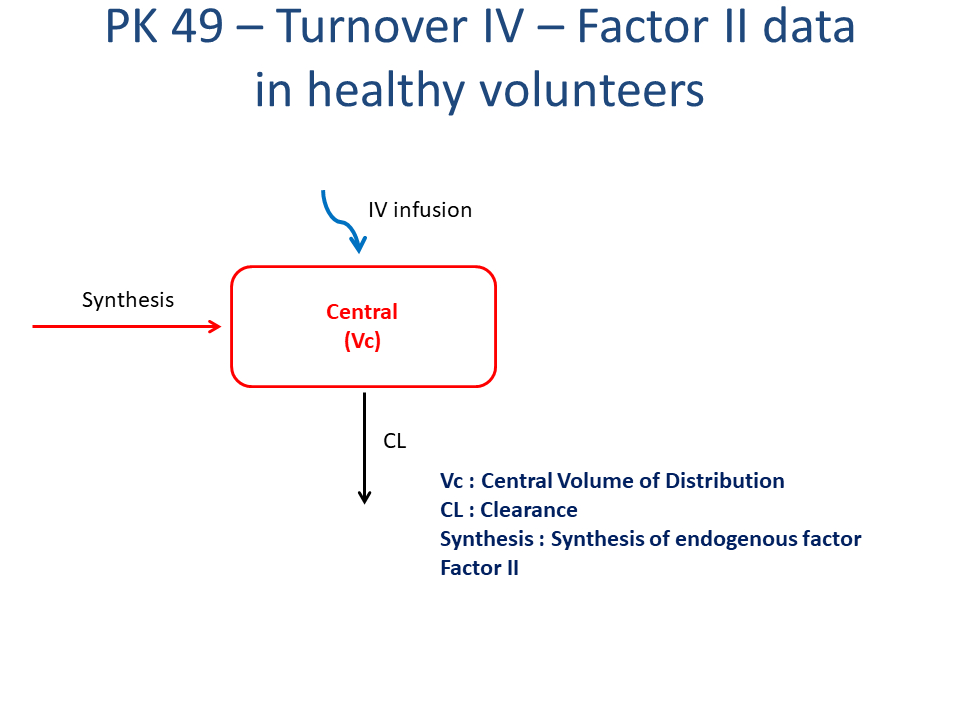using PumasUtilities
using Random
using Pumas
using CairoMakie
using AlgebraOfGraphics
using CSV
using DataFramesMeta
using Dates
PK49 - Turnover IV - Factor II data in healthy volunteers
1 Background
- Structural model - One compartment turnover model
- Route of administration - Intravenous infusion
- Dosage Regimen - 400 mg dose given as a 19 minute constant intravenous infusion
- Number of Subjects - 1 (Healthy Volunteer)

2 Learning Outcome
This exercise demonstrates simulating constant IV infusion kinetics from a one compartment turnover model.
3 Objectives
To build one compartment turnover model with constant intravenous infusion and simulate the model for a single subject, and subsequently perform a simulation for a population.
4 Libraries
Load the necessary libraries.
5 Model Definition
Note the expression of the model parameters with helpful comments. The model is expressed with differential equations. Residual variability is an additive error model.
pk_49 = @model begin
@metadata begin
desc = "One Compartment Model"
timeu = u"hr"
end
@param begin
"""
Clearance (L/hr)
"""
tvcl ∈ RealDomain(lower = 0)
"""
Volume of Central Compartment (L)
"""
tvvc ∈ RealDomain(lower = 0)
"""
Synthesis of endogenous coagulation Factor II (mg/hr)
"""
tvsynthesis ∈ RealDomain(lower = 0)
Ω ∈ PDiagDomain(3)
"""
Additive RUV
"""
σ_add ∈ RealDomain(lower = 0)
end
@random begin
η ~ MvNormal(Ω)
end
@pre begin
CL = tvcl * exp(η[1])
Vc = tvvc * exp(η[2])
Synthesis = tvsynthesis * exp(η[3])
end
@init begin
Central = Synthesis / (CL / Vc) # We add Vc here because we want it in "amount". not conc.
end
@dynamics begin
Central' = Synthesis - (CL / Vc) * Central
end
@derived begin
cp = @. Central / Vc
"""
Observed Concentration (μg/L)
"""
dv ~ @. Normal(cp, σ_add)
end
endPumasModel
Parameters: tvcl, tvvc, tvsynthesis, Ω, σ_add
Random effects: η
Covariates:
Dynamical system variables: Central
Dynamical system type: Matrix exponential
Derived: cp, dv
Observed: cp, dv6 Initial Estimates of Model Parameters
The model parameters for simulation are the following. Note that tv represents the typical value for parameters.
Cl- Clearance (L/hr)Vc- Volume of Central Compartment (L)Synthesis- Synthesis of endogenous coagulation Factor II (mg/hr)Ω- Between Subject Variabilityσ- Residual error
param = (;
tvcl = 0.14204,
tvvc = 3.59259,
tvsynthesis = 16.2272,
Ω = Diagonal([0.01, 0.01, 0.01]),
σ_add = 2.96,
)7 Dosage Regimen
Dosage Regimen - 400 mg of an IV-Infusion over a period of 19 minutes in a healthy individual.
ev1 = DosageRegimen(400, cmt = 1, duration = 0.3166)| Row | time | cmt | amt | evid | ii | addl | rate | duration | ss | route |
|---|---|---|---|---|---|---|---|---|---|---|
| Float64 | Int64 | Float64 | Int8 | Float64 | Int64 | Float64 | Float64 | Int8 | NCA.Route | |
| 1 | 0.0 | 1 | 400.0 | 1 | 0.0 | 0 | 1263.42 | 0.3166 | 0 | NullRoute |
8 Single-individual that receives the defined dose
sub1 = Subject(id = 1, events = ev1)Subject
ID: 1
Events: 19 Single-Subject Simulation
Simulate for plasma concentration with the specific observation time points after Intravenous administration.
Initialize the random number generator with a seed for reproducibility of the simulation.
Random.seed!(123)Define the timepoints at which concentration values will be simulated.
sim_sub1 = simobs(
pk_49,
sub1,
param,
obstimes = [
0.01,
0.05,
0.08,
0.16,
0.25,
0.5,
1,
2,
3,
4,
5,
6,
7,
8,
9,
12,
15,
18,
24,
32,
48,
72,
96,
144,
],
)SimulatedObservations
Simulated variables: cp, dv
Time: [0.01, 0.05, 0.08, 0.16, 0.25, 0.5, 1.0, 2.0, 3.0, 4.0 … 9.0, 12.0, 15.0, 18.0, 24.0, 32.0, 48.0, 72.0, 96.0, 144.0]10 Visualize Results
@chain DataFrame(sim_sub1) begin
dropmissing(:cp)
data(_) *
mapping(:time => "Time (hours)", :cp => "Concentration (μg/L)") *
visual(Lines; linewidth = 4)
draw(; figure = (; fontsize = 22), axis = (; xticks = 0:20:160, yticks = 80:20:240))
end11 Population Simulation
We perform a population simulation with 85 participants.
This code demonstrates how to write the simulated concentrations to a comma separated file (.csv).
par = (;
tvcl = 0.14204,
tvvc = 3.59259,
tvsynthesis = 16.2272,
Ω = Diagonal([0.04261, 0.025, 0.001]),
σ_add = 7.9609,
)
ev1 = DosageRegimen(400, cmt = 1, duration = 0.3166)
pop = map(i -> Subject(id = i, events = ev1), 1:85)
Random.seed!(1234)
pop_sim = simobs(
pk_49,
pop,
par,
obstimes = [
0.01,
0.05,
0.08,
0.16,
0.25,
0.5,
1,
2,
3,
4,
5,
6,
7,
8,
9,
12,
15,
18,
24,
32,
48,
72,
96,
144,
],
)
pkdata_49_sim = DataFrame(pop_sim)
#CSV.write("pk_49_sim.csv", pkdata_49_sim)12 Conclusion
This tutorial showed how to build a one compartment turnover model with constant intravenous infusion and perform a single subject and population simulation.